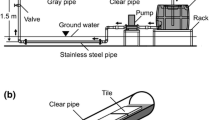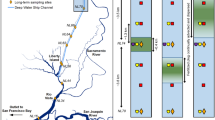Abstract
Loss of cryptophyte cells entrained in the Surry Power Plant cooling water was significantly correlated with discharge water temperature in the range 27.2–37.5 °C. Entrained Skeletonema costatum and benthic diatom populations experienced losses of 25–80% in the summer, but correlations between % loss and discharge temperature were insignificant. Cropping by benthic filter feeders in the intake and discharge canals could account for the summer removal of diatoms. Shortening of entrained S. costatum chains was detected in both winter and summer, indicating a mechanical effect of turbulence.
Benthic diatoms were vulnerable to entrainment only during daylight hours, when they migrated to the sediment surface at low tide. Skeletonema costatum was most vulnerable in the summer, when elevated salinities permitted it to range upstream to the intake area. Cryptophyte populations peaked in the summer when entrainment loss was greatest.
The composition of the entrained phytoplankton community was altered by the species specific interactions of factors affecting vulnerability and entrainment loss. At Surry the discharged cooling water mixes rapidly with the main stem James River, and the selective effects of entrainment are not detectable in phytoplankton samples taken beyond the immediate discharge zone. More persistent modifications of the phytoplankton could be expected at sites where power plants discharge into creeks or embayments.
Similar content being viewed by others
References
Briand, F. J.-P., 1975. Effects of power-plant cooling systems on marine phytoplankton. Mar. Biol. 33: 135–146.
Brooks, A. S., 1974. Phytoplankton entrainment studies at the Indian River Estuary, Delaware. In: Jensen, L. D. (ed.). Second Workshop on Entrainment and Intake Screening. Report 15. The John Hopkins University Department of Oceanography and Environmental Engineering, Baltimore: 105–111.
Cloern, J. E., 1977. Effects of light intensity and temperature on Cryptomonas ovata (Cryptophyceae) growth and nutrient uptake rates. J. Phycol. 13: 389–395.
Crippen, R. W., Fahmy, F. K., Seepersad, B. & Hayton, A. M., 1978. Impacts of three types of power generating discharge systems on entrained plankton. In: Jensen, L. D. (ed.). Fourth National Workshop on Entrainment and Impingement. Ecological Analysts, Melville, N.Y.: 191–202.
Eltringham, S. K., 1971. Life in Mud and Sand. English University Press, Lond., 218 pp.
Fang, C. S. & Parker, G. C., 1976. Thermal effects of the Surry Nuclear Power Plant on the James River, Virginia. 4. Results of monitoring physical parameters. Special Report in Applied Marine Science and Ocean Engineering 109. Virginia Inst. Mar. Sc., Gloucester Point, Va., 114 pp.
Flemer, D. & Sherk, J. A., Jr., 1977. The effects of steam electric station operation on entrained phytoplankton. Hydrobiologia 55: 33–44.
Gammon, J. R., 1976. Measurement of entrainment and predictions of impact on the Wabash and Ohio Rivers. In: Jensen, L. D. (ed.). Third National Workshop on Entrainment and Impingement. Ecological Analysts, Melville, N.Y.: 159–176.
Goldman, J. C. & Quinby, H. L., 1979. Phytoplankton recovery after power plant entrainment. J. Wat. Pollut. Cont. Fed. 51: 1816–1823.
Hasle, G. R., 1978. Using the inverted microscope. In: Sournia, A. (ed.).Phytoplankton Manual. Monographs on Oceanographic Methodology 6. United Nations Educational, Scientific, and Cultural Organization, Paris: 191–196.
Jordan, R. A., Goodwin, P. A. & Sutton,C. E.,1980. Ecological study of the tidal segment of the James River encompassing Hog Point (site of the Surry Nuclear Power Station). Special Scientific Report 101. Virginia Inst. Mar. Sc. Gloucester Point, Va., 414 pp.
Marshall, H. G., 1966. The distribution of phytoplankton along a 140 mile transect in the Chesapeake Bay. Virginia J. Sci. 17: 105–119.
Mountford, K., Mullen, R. S. & Shippen, R. S., 1974. Laboratory simulation of power plant effects: Response of some estuarine phytoplankters to time temperature combinations. In: Jensen, L. D. (ed.). Second Workshop on Entrainment and Intake Screening. Report 15. The Johns Hopkins University Department of Oceanography and Environmental Engineering, Baltimore: 193–198.
Mulford, R. A., 1974. Morgantown entrainment. Part IV. Phytoplankton taxonomic studies. In: Jensen, L. D. (ed.). Second Workshop on Entrainment and Intake Screening. Report 15. The Johns Hopkins University Department of Oceanography and Environmental Engineering, Baltimore: 169–175.
Olson, D. H., 1979. Particle size selectivity in Modiolus demissus and Balanus balanoides. Biol. Bull. mar. biol. Lab., Woods Hole 157: 386.
Pritchard-Carpenter, Consultants, 1967. Temperature distribution in the James River estuary which will result from the discharge of waste heat from the Surry Nuclear Power Station. Appendix B, Surry Power Station Units I and 2, Applicant's Environmental Report, Dockets 50–280, 281. Virginia Electric and Power Company, Richmond, Va.
Ritz, D. A. & Crisp, D. J., 1970. Seasonal changes in feeding rate in Balanus balanoides. J. mar. biol. Ass. U.K. 50: 223–240.
Round, F. E. & Palmer, J. D., 1966. Persistent vertical-migration rhythms in benthic microflora. 2. Field and laboratory studies on diatoms from the banks of the River Avon. J. mar. biol. Ass. U.K. 46: 191–214.
Schöne, H. K., 1970. Untersuchungen zur ökologischen Bedeutung des Seegangs für das Plankton mit besonderer Berück-sichtigung mariner Kieselalgen. Int. Revue ges. Hydrobiol. 55: 595–677.
Schubel, J. R., Coutant, C. C. & Woodhead, P. M. J., 1978. Thermal effects of entrainment. In: Schubel, J. R. & Marcy, B. C., Jr., (eds.). Power Plant Entrainment, a Biological Assessment, Academic Press, N.Y.: 19–94.
Smith, R. A., Brooks, A. S. & Jensen, L. D., 1974.Effects of condenser entrainment on algal photosynthesis at Mid-Atlantic power plants. In: Jensen, L. D. (ed.). Second Workshop on Entrainment and Intake Screening. Report 15. The Johns Hopkins University Department of Oceanography and Environmental Engineering, Baltimore: 113–122.
Southward, A. J., 1955. Feeding of barnacles. Nature175: 1124–1125.
Steel, R. J. & Torrie, J. H., 1960. Principles and Procedures of Statistics with Special Reference to the Biological Sciences. McGraw-Hill, N.Y., 481 pp.
Warinner, J. E. & Brehmer, M. L., 1966. The effects of thermal effluents on marine organims. Air Wat. Pollut. int. J. 10: 277–289.
Welch, M. O. & Ward, C. H., 1978. Primary productivity: analysis of variance in a thermally enriched aquatic system. In: Thorp, J. H. & Gibbons, J. W. (eds.). Energy and Environmental Stress in Aquatic Systems. DOE Symp. Ser. 48. U.S. Dept. Energy tech. Inf. Center: 381–391.
Author information
Authors and Affiliations
Additional information
Contribution No. 1106, Virginia Institute of Marine Science.
Contribution No. 1106, Virginia Institute of Marine Science.
Rights and permissions
About this article
Cite this article
Jordan, R.A., Martin, P.G. & Sutton, C.E. Selective effects of phytoplankton entrainment at the Surry Power Plant, James River, Virginia. Hydrobiologia 106, 253–261 (1983). https://doi.org/10.1007/BF00008124
Published:
Issue Date:
DOI: https://doi.org/10.1007/BF00008124




